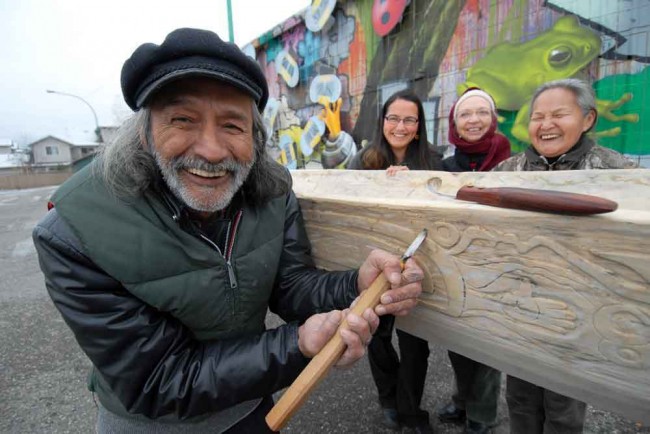
Photo Credit: Shawn Hayward
Where is here?
Lheidli-Prince George history is coming alive before our eyes.
Through the courage and hard work of elders, artists and other leaders, Lheidli T’enneh culture is re-emerging in this place. This resurgence comes from the indigenous families and the resolve of First Nations communities, but also, I believe, comes from a growing awareness, an awakening, on behalf of settlers. This change in climate seems to be heralding a new era of cultural understanding and openness to questions concerning where we are and the colonial context in which we live.
The Idle No More movement and, before that, the Nisga’a Treaty and the formation of a strong independent Haida Nation, has created a fascinating political environment and a unique opportunity for northern BC to influence world politics.
It is no coincidence that the North is one of the world’s greatest undeveloped (in the European-modelled agrarian-industrial sense) expanse of land and also some of the most concerted examples of indigenous counter-colonial activity. The land sustains hope.
The connection between land and culture was recently reiterated by Thomas King in The Inconvenient Indian:
“Land. If you understand nothing else about the history of Indians in North America, you need to understand that the question that really matters is the question of land. Land contains the languages, the stories and the histories of a people. It provides water, air, shelter and food. And land is home.”
This connection is subtly imprinted in the new offerings of the First Nations Studies Department at UNBC. The Making a Cottonwood Canoe course was the completion of a canoe made from scratch, which was subsequently launched into the Nechako River at the Lhezbaoonicheck reserve, where the course took place. Lheidli elder, storyteller and carver Robert Frederick says this was the first time a cottonwood canoe has been launched in 60 years.
Frederick carved one side before it was gifted to UNBC and the students carved the second side in the winter 2013 course. The canoe’s carvings tell the Lheidli traditional story of the salmon, featuring the figures Eustace and Raven. The course, taught by Frederick with the assistance of Edie Frederick and Jennifer Pighin, demonstrated the connections between the land, the cottonwood tree, the river, the story, traditional tools and methods, and the carved images transmitting the culture of the Lheidli T’enneh.
The canoe was recently displayed at the triumphant opening of NEKEYOH: Our Home at Prince George’s Two Rivers Gallery. This show featured a variety of art forms by and about the Lheidli T’enneh. It is permanently displayed at UNBC, with the June 21 unveiling (National Aboriginal Day) part of UNBC’s 25th anniversary celebrations.
I look forward to more cultural revival as northern BC further allies itself with First Nations and their efforts to retain their culture and maintain the land. And, more than that, I imagine historians might look back at the North at this time and realize it was a turning point for indigenous rights, for environmental justice and for the health of the planet.


